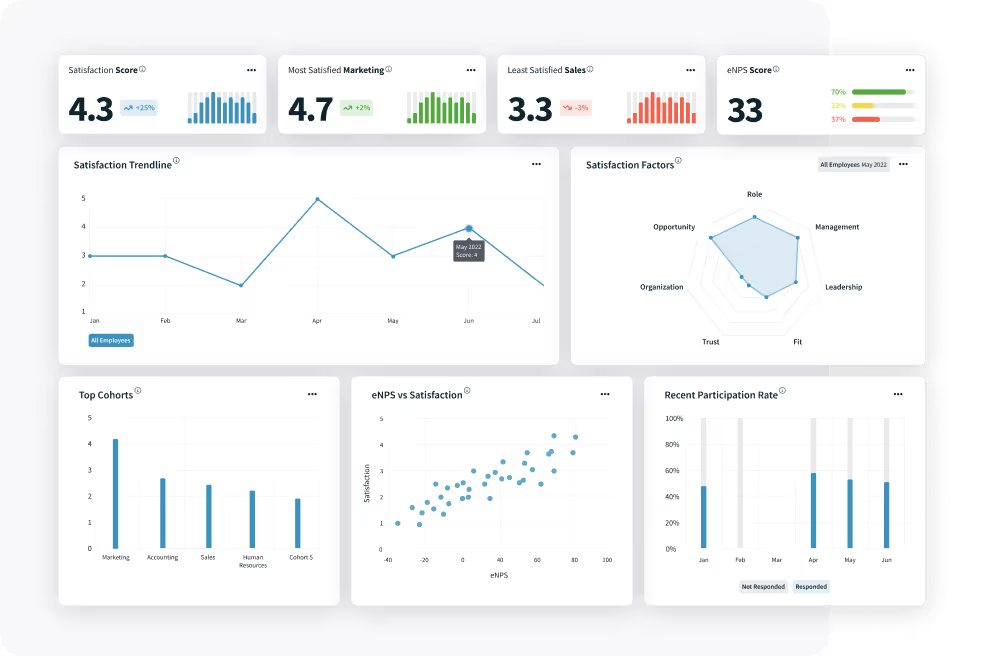Popular Employee Engagement Initiatives for HR - 10 Ideas & Examples
Employee engagement has emerged as a crucial determinant of organizational success. Companies are striving to foster a motivated and productive workforce. It's now more important to implement effective employee engagement initiatives.
The benefits of employee engagement initiatives include boosting satisfaction, loyalty, and well-being. They are key to driving performance and meeting strategic goals.
But, creating and executing employee engagement initiatives is a complex task. It must begin with understanding the workforce's unique needs and aspirations.
This article discusses the benefits of employee engagement initiatives and examples of common initiatives in the workplace.
How Engagement Initiatives Can Improve an Organization
Employee engagement activities can affect employee temperament. Engaged employees feel more valuable in their company, thereby impacting their productivity. Here are additional ways employee engagement programs can improve an organization:
- Increased Productivity. Engaged employees are more motivated and committed to their work. This leads to higher levels of productivity and efficiency.
- Reduced Turnover. Engagement initiatives help create a positive work environment. These environments allow employees to feel capable and comfortable in their positions. This reduces employee turnover rates and the costs of hiring and training new staff.
- Improved Employee Morale. Regular recognition and rewards contribute to higher employee morale. Showing employees you recognize and appreciate the work they put in allows for increased loyalty and satisfaction.
- Enhanced Innovation. Engaged employees are more likely to contribute innovative ideas and solutions. Keeping employees engaged helps creativity and competitive advantage.
- Better Customer Service. Valued, engaged employees are more likely to provide great customer service. An engaging environment makes customers feel more valued and helped.
- Higher Retention Rates. Career development and personal growth initiatives help retain top talent. Keeping these valuable members of your team is more vital than ever because of increased job-hopping.
- Stronger Company Culture. A focus on engagement helps build a strong, cohesive company culture that aligns with organizational values and goals.
- Improved Employee Health and Well-being. Programs that promote work-life balance boost employee health and happiness. Work-life balance is becoming a priority, so initiatives to keep this balance are essential. Prioritizing the well-being of your employees keeps them satisfied and comfortable.
- Increased Profitability. Companies with highly engaged employees often see higher profits. This is due to better performance, customer satisfaction, and lower costs. With fewer expenses from training new staff and correcting unengaged staff’s mistakes, profits are higher for engaged workplaces.
- Enhanced Employer Brand. A strong engagement strategy enhances the company’s reputation as a desirable place to work. When attracting top talent, having a reputation as a pleasant place to work drives the ability to get even more talented employees.
- Greater Alignment with Organizational Goals. Engaged employees are more likely to understand and align with the company’s mission and objectives. This ensures everyone is working towards common goals that they fundamentally agree with.
- Better Communication and Collaboration. Engagement initiatives often promote open communication and collaboration, leading to more effective teamwork and problem-solving.
» HR Insights: Employee Experience vs. Employee Engagement

10 Examples of Employee Engagement Initiatives
- Recognition Programs: Implement regular recognition programs to celebrate employee achievements and milestones. The program should be trackable and specific within certain aspects of the organization. This can include awards, shout-outs in meetings, or a dedicated recognition platform to boost morale and motivation.
- Professional Development Opportunities: Offer training sessions, workshops, and courses to help employees develop new skills and advance their careers. Providing opportunities for growth shows that the company values its employees’ long-term development.
- Flexible Work Arrangements: Allow flexible hours or remote work to help employees' work-life balance. Allowing employees to choose how they work can make your organization more approachable and sought after. This can lead to increased job satisfaction and reduced stress.
- Wellness Programs: Create wellness programs that focus on physical, mental, and emotional health. This can include fitness challenges, mental health resources, and wellness workshops. They aim to promote a healthy lifestyle.
- Employee Feedback Systems: Establish regular feedback mechanisms such as engagement surveys, suggestion boxes, or town hall meetings. Open communication can help employees feel heard and validated. Open communication also lets employers change parts of the job that people find unpleasant or unproductive.
- Team-building Activities: Organize team-building events and activities to strengthen relationships among employees. These can range from offsite retreats to fun in-office challenges that encourage collaboration and camaraderie.
- Mentorship Programs: Pair experienced employees with newer team members in a mentorship program. This fosters knowledge sharing, professional growth, and a sense of community within the organization.
- Community Involvement: Encourage employees to participate in community service or volunteer projects. Enabling your team members to engage within their communities can foster a better sense of unity within the team. It gives back to the community and builds team spirit and a sense of purpose.
- Employee Resource Groups (ERGs): Support forming ERGs based on shared traits or interests, like culture, gender, or hobbies. ERGs can provide networking opportunities and a sense of belonging. Creating these groups allows for better communication and increased development opportunities.
- Creative Workspaces: Design workspaces that inspire creativity and productivity. This can include collaborative areas, quiet zones, and spaces that reflect the company culture and values. A well-designed workspace can enhance employee engagement and satisfaction.
» How to Build an Effective Employee Engagement Feedback Model
Leveraging Technology to Improve Employee Engagement
Creating effective employee engagement initiatives requires strategic planning and the right tools. PerformYard offers features that enhance the design and implementation of these initiatives.
For example, PerformYard’s goal-setting capabilities align individual employee goals with organizational objectives, helping employees see their contributions to the company's success, thus fostering engagement.
Meanwhile, PerformYard makes it easy to celebrate successes with public shout-outs, badges, or awards. This can help boost morale and promote a positive work environment.
Learn more at Employee Engagement Software by PerformYard.





